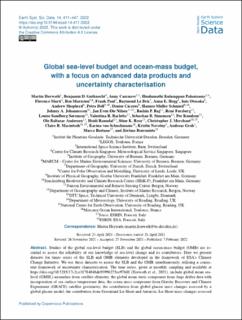| dc.description.abstract | Studies of the global sea-level budget (SLB) and the global ocean-mass budget (OMB) are essential to assess the reliability of our knowledge of sea-level change and its contributors. Here we present datasets for times series of the SLB and OMB elements developed in the framework of ESA's Climate Change Initiative. We use these datasets to assess the SLB and the OMB simultaneously, utilising a consistent framework of uncertainty characterisation. The time series, given at monthly sampling and available at https://doi.org/10.5285/17c2ce31784048de93996275ee976fff (Horwath et al., 2021), include global mean sea-level (GMSL) anomalies from satellite altimetry, the global mean steric component from Argo drifter data with incorporation of sea surface temperature data, the ocean-mass component from Gravity Recovery and Climate Experiment (GRACE) satellite gravimetry, the contribution from global glacier mass changes assessed by a global glacier model, the contribution from Greenland Ice Sheet and Antarctic Ice Sheet mass changes assessed by satellite radar altimetry and by GRACE, and the contribution from land water storage anomalies assessed by the global hydrological model WaterGAP (Water Global Assessment and Prognosis). Over the period January 1993–December 2016 (P1, covered by the satellite altimetry records), the mean rate (linear trend) of GMSL is 3.05 ± 0.24 mm yr−1. The steric component is 1.15 ± 0.12 mm yr−1 (38 % of the GMSL trend), and the mass component is 1.75 ± 0.12 mm yr−1 (57 %). The mass component includes 0.64 ± 0.03 mm yr−1 (21 % of the GMSL trend) from glaciers outside Greenland and Antarctica, 0.60 ± 0.04 mm yr−1 (20 %) from Greenland, 0.19 ± 0.04 mm yr−1 (6 %) from Antarctica, and 0.32 ± 0.10 mm yr−1 (10 %) from changes of land water storage. In the period January 2003–August 2016 (P2, covered by GRACE and the Argo drifter system), GMSL rise is higher than in P1 at 3.64 ± 0.26 mm yr−1. This is due to an increase of the mass contributions, now about 2.40 ± 0.13 mm yr−1 (66 % of the GMSL trend), with the largest increase contributed from Greenland, while the steric contribution remained similar at 1.19 ± 0.17 mm yr−1 (now 33 %). The SLB of linear trends is closed for P1 and P2; that is, the GMSL trend agrees with the sum of the steric and mass components within their combined uncertainties. The OMB, which can be evaluated only for P2, shows that our preferred GRACE-based estimate of the ocean-mass trend agrees with the sum of mass contributions within 1.5 times or 0.8 times the combined 1σ uncertainties, depending on the way of assessing the mass contributions. Combined uncertainties (1σ) of the elements involved in the budgets are between 0.29 and 0.42 mm yr−1, on the order of 10 % of GMSL rise. Interannual variations that overlie the long-term trends are coherently represented by the elements of the SLB and the OMB. Even at the level of monthly anomalies the budgets are closed within uncertainties, while also indicating possible origins of remaining misclosures. | en_US |
